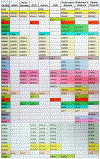Brain injury and inflammation genes common to a number of neurological diseases and the genes involved in the genesis of GABAnergic neurons are altered in monoamine oxidase B knockout mice
- PMID: 34780749
- PMCID: PMC8638699
- DOI: 10.1016/j.brainres.2021.147724
Brain injury and inflammation genes common to a number of neurological diseases and the genes involved in the genesis of GABAnergic neurons are altered in monoamine oxidase B knockout mice
Abstract
Monoamine oxidase B (MAO B) oxidizes trace amine phenylethylamine (PEA), and neurotransmitters serotonin and dopamine in the brain. We reported previously that PEA levels increased significantly in all brain regions, but serotonin and dopamine levels were unchanged in MAO B knockout (KO) mice. PEA and dopamine are both synthesized from phenylalanine by aromatic L-amino acid decarboxylase in dopaminergic neurons in the striatum. A high concentration of PEA in the striatum may cause dopaminergic neuronal death in the absence of MAO B. We isolated the RNA from brain tissue of MAO B KO mice (2-month old) and age-matched wild type (WT) male mice and analyzed the altered genes by Affymetrix microarray. Differentially expressed genes (DEGs) in MAO B KO compared to WT mice were analyzed by Partek Genomics Suite, followed by Ingenuity Pathway Analysis (IPA) to assess their functional relationships. DEGs in MAO B KO mice are involved in brain inflammation and the genesis of GABAnergic neurons. The significant DEGs include four brain injury or inflammation genes (upregulated: Ido1, TSPO, AVP, Tdo2), five gamma-aminobutyric acid (GABA) receptors (down-regulated: GABRA2, GABRA3, GABRB1, GABRB3, GABRG3), five transcription factors related to adult neurogenesis (upregulated: Wnt7b, Hes5; down-regulated: Pax6, Tcf4, Dtna). Altered brain injury and inflammation genes in MAO B knockout mice are involved in various neurological disorders: attention deficit hyperactive disorder, panic disorder, obsessive compulsive disorder, autism, amyotrophic lateral sclerosis, Parkinson's diseases, Alzheimer's disease, bipolar affective disorder. Many were commonly involved in these disorders, indicating that there are overlapping molecular pathways.
Keywords: GABAnergic neuron; Inflammation; Monoamine oxidase B; Phenylethylamine.
Copyright © 2021 Elsevier B.V. All rights reserved.
Conflict of interest statement
Declarations of interest: none.
Figures



References
Publication types
MeSH terms
Substances
Grants and funding
LinkOut - more resources
Full Text Sources
Molecular Biology Databases
Research Materials
Miscellaneous

